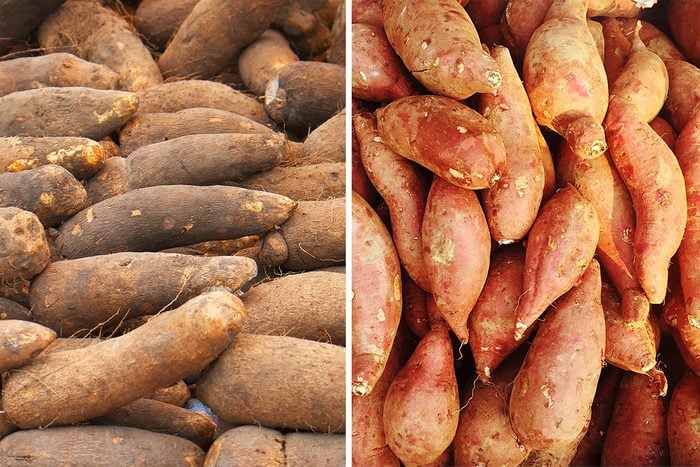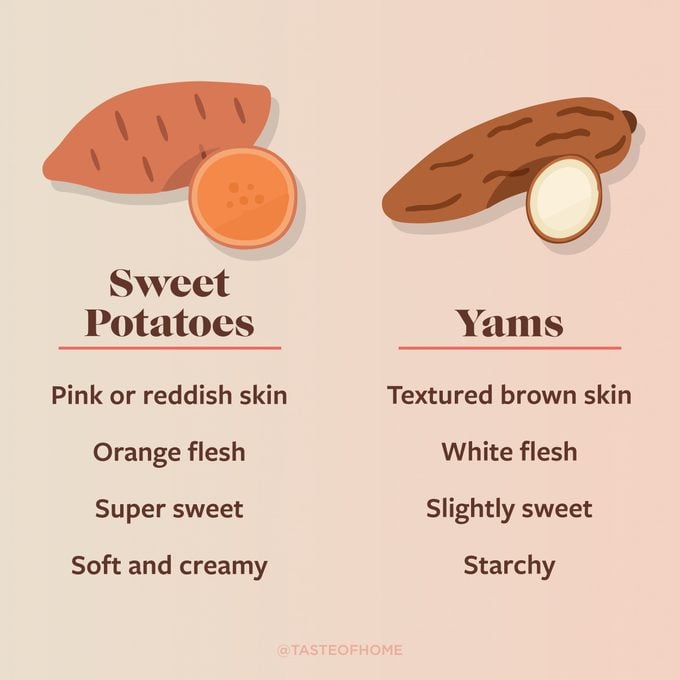Yams vs. Sweet Potatoes: What’s the Difference?
Updated: Aug. 17, 2023

Yams, sweet potatoes; tomato, to-mah-to...right? Turns out, there's a big difference between the two vegetables. Find out which one you should be using: yams vs sweet potatoes.
Growing up, yams were one of my favorite vegetables. Not surprising, since we mostly ate them in the classic casserole with toasted marshmallows.
Imagine my surprise when, as an adult, I learned that I’d never actually eaten a yam. The bright orange, sweet tuber I liked so much was actually the sweet potato. I’m not the only one confused when it comes to yams vs. sweet potatoes. The names are used in grocery stores and recipes pretty interchangeably—but that doesn’t make the vegetables themselves interchangeable.
On This Page
Are Yams the Same as Sweet Potatoes?

Yams and sweet potatoes are not the same! Though both are root vegetables, they actually grow, look, taste, cook and keep differently. They don’t even belong to the same plant family, and they originate and grow on different continents!
There are several theories on how the names got mixed up. One is that firm sweet potatoes were cultivated in the US first, and when farmers brought soft varietals to market, they wanted to differentiate the types. Because soft sweet potatoes, with their darker skins look something like yams, the name transferred.
Around Thanksgiving, you’ll often see sweet potatoes, both raw and canned, proudly labeled “yams.” It’s confusing, but these super-sweet potatoes are the ones you want to add to your favorite Thanksgiving recipes.
What Are Yams?
Yams are tubers of a tropical flowering vine, a plant family that includes lilies. Yams originated in Africa, and are popular in African, South American and Caribbean cuisine. A purple variety is enjoyed across Southeast Asia.
A yam’s appearance is distinctive, with textured brown skin that resembles scales or even bark. They can grow quite large: over seven feet long, and into the triple digits in weight! Yams can have a similar shape to sweet potatoes, with tapered ends and scattered “dimples” in the skin. The flesh of yams, however, is white.
Yams are a kitchen staple in many cuisines. They’re starchy, with a neutral flavor that’s only slightly sweet. Cooks prize their ability to take on the flavors of a huge variety of dishes. They have a long shelf life, too, of about six months.
How to Cook Yams
Yams can be fried, roasted, boiled and mashed. They can even be dried and ground into a powder that’s used to make a thick pudding. In some countries, purple yams are used to make dessert like jams and cakes, similar to the way we use zucchini in baked goods.
For a sweet treat, try these Yam-Yam Honey Buns.
What Are Sweet Potatoes?
Sweet potatoes, part of the morning glory family, likely originated in Central or South America. They’re widely eaten in the Americas and are especially popular in the American South. Sweet potatoes are, obviously, very sweet. They’re generally less than a foot in length, with tapered ends. Because they’re cured after harvest, their shelf life is very long: over a year!
The sweet potato is an important source of starch, and therefore fiber. Compared to the yam, they have less calories, more vitamin C and significantly more vitamin A.
There are two main types of sweet potatoes: firm and soft.
Firm sweet potatoes have paler golden skins and dry, flaky flesh, like many types of baking potatoes. You may also find purple varietals, especially at the farmers market, with nutrient-rich purple skins and flesh. Firm sweet potatoes hold their shape well after cooking, making them ideal for frying, stews or curries.
Common firm varietals include Jewel, Garnet and purple sweet potatoes.
Soft sweet potatoes have darker pink or reddish skin and orange flesh. This variety is more likely to be mislabeled as yams. When cooked, it becomes silky smooth and creamy or fluffy. Both naturally sweet and moist, soft sweet potatoes are popular additions to many sweet potato dessert recipes.
Common soft varietals include the most common grocery store sweet potato, the Beauregard, which has bright orange, super-sweet flesh that’s ideal for baking; and the Covington, a type popular in the South for roasting and eating plain.
How to Cook Sweet Potatoes
Like yams, sweet potatoes are incredibly versatile in the kitchen. They can be roasted or baked (whole or chopped), steamed, boiled, sauteed, pureed and fried. Sweet potatoes are as delicious in a soup as they are in a sweet potato pie; as delightful in a spicy curry as in a muffin. On their own, roasted sweet potatoes make a nutritious lunch served with nuts and cheese. Add them to salads, tacos, stuffing or grain bowls. Seriously, there are so many sweet potato recipes!
